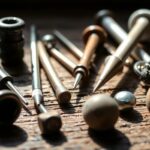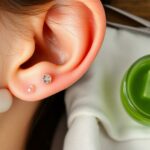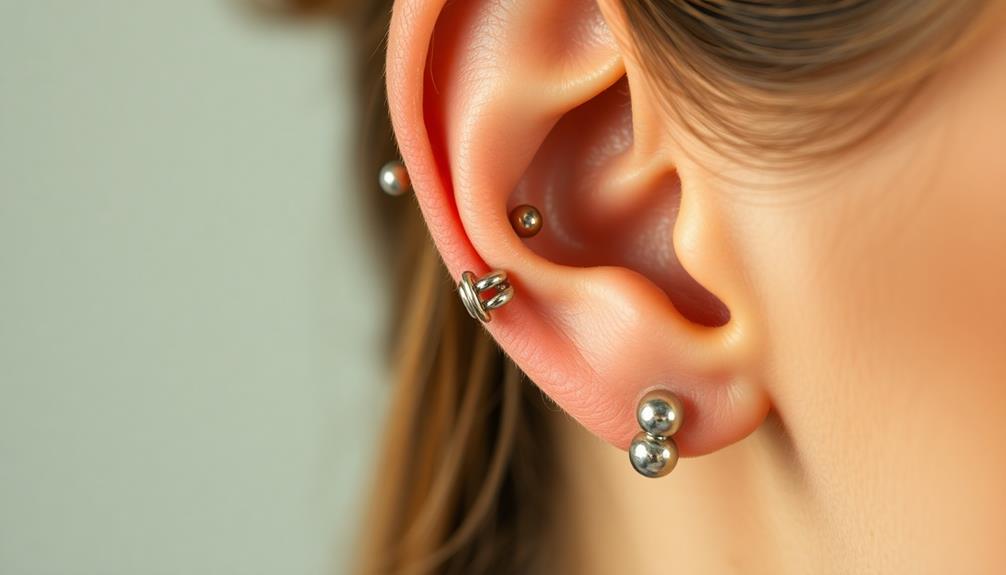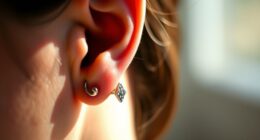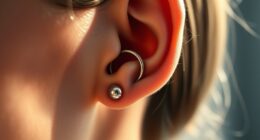As you age, your piercings change, particularly in your earlobes. They may sag and lose volume, just like balloons gradually deflate. Heavy earrings contribute to this stretching, leading to elongated holes that often don't shrink. The skin around the piercings loses elasticity, resulting in wrinkles and folds. Other piercings can also suffer, with increased sensitivity and a higher chance of complications like keloids. To counter these effects, you can explore rejuvenation techniques, such as fillers or corrective surgery. Discovering the right care and treatment can help maintain your look as you navigate the years ahead.
Key Takeaways
- Aging causes earlobes to sag and lose volume due to soft tissue atrophy and collagen loss.
- Heavy earrings can exacerbate droopiness, stretching earlobes and elongating piercing holes.
- Surface piercings may become more prone to rejection and irritation as skin elasticity decreases with age.
- Keloid formation risks increase with aging, complicating the appearance of existing piercings.
- Regular maintenance and post-care are essential to prevent infections and promote healing in aging piercings.
Changes in Earlobes Over Time

Have you ever noticed how your earlobes change as you age? It's a natural process, but it can be surprising. Over time, your earlobes may become droopy and deflated due to soft tissue atrophy and loss of collagen.
You might find that the skin on your earlobes loses elasticity, leading to folds and wrinkles that didn't exist before. If you've worn heavy earrings for years, the weight can stretch your earlobes, creating elongated holes that may not shrink back to their original size even after you remove the earrings.
As you continue to age, factors like gravity and hormonal changes can cause your earlobes to enlarge further. You might even notice that they become more prominent, especially after undergoing facelift surgery, which brings attention to your facial aesthetics.
If you're unhappy with these changes, you might consider earlobe repair to restore a more youthful appearance. Whether you want to address the effects of aging or the impact of ear piercings, understanding these changes can help you make informed decisions about your earlobes and their care as you age.
Rejuvenation Techniques for Earlobes

If you're looking to refresh your earlobes, several rejuvenation techniques can help restore their youthful appearance.
You might consider options like volume fillers for added fullness, or surgical repair techniques if you have large holes from previous piercings.
Proper aftercare is also essential to guarantee ideal results and maintain the improvements you achieve.
Volume Fillers Options
As you age, the loss of volume in your earlobes can become more noticeable, but volume fillers offer effective rejuvenation options to restore their youthful appearance. Products like RADIESSE are specifically designed to enhance the shape, size, and fullness of aging earlobes, giving you back that youthful look.
When considering volume fillers, a holistic approach is essential. A skilled professional will assess your earlobes' overall aesthetics and how they balance with your face to guarantee a harmonious result. Typically, just a small volume of filler, around 0.5 cc, can make a significant difference.
Using hyaluronic acid fillers not only boosts earlobe volume but also smooths out wrinkles, making your piercing jewelry look even more appealing. You'll find that earrings sit better and look more attractive, enhancing your overall style.
The results of earlobe rejuvenation are long-lasting, typically around 9 to 12 months, before you'll need maintenance treatments. If you're looking to reclaim the fullness in your earlobes and enhance your piercing jewelry, volume fillers can be an excellent option for you.
Surgical Repair Techniques
Earlobe rejuvenation isn't limited to volume fillers; surgical repair techniques can also restore a youthful appearance.
If you're considering earlobe repair, you'll be relieved to know the process typically involves corrective surgery performed under local anesthesia. During the procedure, excess skin is removed, and the opening is sewn closed, resulting in a more youthful look.
The cost of earlobe repair ranges from $300 to $1,000, depending on the complexity and the number of ears treated.
For those looking to enhance earlobe fullness simultaneously, options like RADIESSE volume fillers can complement surgical techniques, addressing both aesthetic and structural concerns.
Fortunately, complications from earlobe repair are minimal. You'll likely resume normal activities within hours, and if you want to re-pierce your earlobes, you can typically do so within days—just at a different location.
Aftercare for Rejuvenation
Following any earlobe rejuvenation procedure, proper aftercare is essential to guarantee ideal healing and minimize complications. Whether you've opted for volume fillers like RADIESSE or corrective surgery, your earlobes need time to recover.
Start by keeping the treated area clean and avoiding any harsh products. Gently cleanse the earlobe with mild soap and water, ensuring you don't irritate the area.
You should also avoid unnecessary manipulation of your earlobes, such as tugging on earrings or touching the site. This prevents stress on the healing tissue. If you experience swelling or discomfort, applying a cold compress can help alleviate these symptoms.
It's vital to follow your practitioner's specific aftercare instructions, as they may provide tailored advice based on your individual needs.
Remember to stay hydrated and maintain a balanced diet to support your body's healing process.
In the days following your procedure, monitor your earlobes for any signs of infection, such as increased redness or discharge. Early detection can help resolve issues quickly, ensuring you enjoy your rejuvenated earlobes without complications.
Impact of Aging on Other Piercings

Over time, you may notice that the impact of aging on piercings becomes more pronounced, especially with surface piercings like those in the navel or eyebrow.
As you age, the skin around these piercings loses elasticity and collagen, leading to a higher risk of rejection and potential migration. This can result in discomfort and may require corrective procedures to restore the appearance.
You might also find that keloid formation becomes more common, causing raised scars around your piercings. This complicates their look and may necessitate additional treatment.
Additionally, aging can increase your sensitivity to materials, making you more susceptible to allergic reactions from jewelry, particularly those containing nickel.
With your skin's healing capacity diminishing, proper aftercare becomes essential. You need to pay careful attention to hygiene and monitor for signs of complications.
Neglecting this can elevate the risk of infection, impacting not just the appearance of your piercings, but also your overall health.
Prioritizing aftercare can help maintain the integrity of your piercings and keep you looking your best as you age.
Causes of Earlobe Sagging

You may not realize it, but heavy earrings can greatly stretch your earlobes over time, leading to that droopy look.
As you age, your skin naturally loses elasticity and strength, which compounds the issue.
Together, these factors contribute to the sagging of your earlobes, making it a common concern for many.
Heavy Earring Influence
Heavy earrings can take a toll on earlobes, leading to noticeable sagging over time. When you wear heavy earrings for extended periods, they contribute considerably to earlobe stretching, causing them to become droopy and deflated.
The persistent weight of large earrings pulls on your earlobes, which can exacerbate the natural aging effects your skin experiences. As gravity works on those heavy earrings, you might start to notice changes similar to what occurs in other areas of your body, like your hands.
The combination of this weight and the skin's loss of elasticity results in earlobes that appear enlarged and sagging. Over time, this stretching can become permanent, leaving you with earlobe holes that no longer look youthful.
If you've noticed your earlobes changing due to heavy earrings, you might find yourself considering corrective procedures, such as earlobe repair, to restore a more youthful appearance.
It's crucial to be mindful of the impact heavy earrings can have on your earlobes, especially if you're aiming for a look that feels fresh and vibrant.
Natural Aging Process
As time goes by, the natural aging process takes a toll on your earlobes, causing them to sag and lose volume. This droopiness results from soft tissue atrophy and a decline in collagen production.
As you age, your skin loses elasticity, further contributing to sagging earlobes that may develop folds over time.
Heavy earrings, especially those worn for years, can exacerbate this sagging. The weight stretches the skin, leading to larger holes in your lobes.
Gravity also plays a significant role in this process, making your earlobes appear longer and more pronounced as you age.
Additionally, factors like pregnancy can weaken the earlobe structure, adding to the sagging.
The cumulative effects of aging on your skin and the persistent weight of your piercings create a perfect storm for earlobe transformation.
It's important to be aware of these changes and consider how they may influence your choices regarding jewelry and earlobe care.
Embracing these natural changes can help you navigate the evolving landscape of your appearance while still enjoying your piercings.
Treatment Options for Sagging Piercings

Considering the effects of aging on piercings, various treatment options exist for addressing sagging earlobes. You can choose between surgical and non-surgical methods, depending on your preferences and budget.
- Corrective Surgery: This option involves a procedure performed under local anesthesia where the opening is sewn closed, and excess skin is removed. The cost ranges from $300 to $1,000, depending on complexity and whether one or both ears are treated.
- Volume Fillers: Non-surgical options like RADIESSE can rejuvenate your earlobes. Fillers restore fullness and help reduce the appearance of sagging, allowing you to wear your favorite earrings with confidence.
- Post-Surgery Care: If you opt for surgery, maintaining proper care of the scar is essential for ideal healing. This minimizes visible marks and prepares your earlobes for potential re-piercing, which can take up to six months in the same location but can be done within days elsewhere.
With these options, you can effectively address sagging earlobes and enjoy your earrings without concern.
Complications of Piercing Repairs

Earlobe repair can enhance your confidence, but it's important to be aware of potential complications that may arise. While the procedure is generally safe and performed under local anesthesia, there's still a risk of infection, similar to other surgical interventions. This risk underscores the significance of diligent post-operative care to promote healing and minimize complications.
After your earlobe repair, you can usually resume normal activities within hours, which is a significant advantage. However, if you plan to re-pierce the same scarred area, it's necessary to wait up to six months. Choosing a different location allows you to re-pierce your earlobes within days, but remember that the healing process varies based on your aftercare.
Proper care of the surgical site is essential. Neglecting this can lead to scarring or other issues that might affect your body piercing experience in the future.
Long-Term Care and Maintenance

To guarantee your piercings remain healthy and vibrant over time, regular care and maintenance are essential. Implementing a solid long-term care routine can greatly reduce the risk of complications and guarantee your piercings look great as the years go by.
Here are three key practices to follow:
- Clean Regularly: Use a saline solution or a recommended cleaner to clean your piercings daily. This helps prevent infections and maintains proper hygiene.
- Avoid Changing Jewelry Too Soon: Resist the temptation to switch out your earrings or jewelry until your piercings have fully healed. Earlobe piercings typically take 6-8 weeks, while cartilage piercings can take 3-12 months.
- Moisturize: Keeping the pierced area moisturized prevents irritation and dryness. This guarantees a more comfortable healing process and promotes overall skin health.
Additionally, schedule regular check-ups with a professional piercer to assess your piercings' condition.
Educate yourself on recognizing signs of complications, like redness or swelling, so you can address issues promptly. Investing in these practices will keep your piercings looking their best for years to come.
Frequently Asked Questions
What Happens to Piercings as You Age?
As you age, your piercings may stretch or sag due to skin elasticity loss. The skin around them thins, and healing slows, potentially leading to complications like keloids or scars from changes in collagen production.
What Is the Cheese Cutter Effect Piercings?
The cheese cutter effect happens when small, heavy earrings stretch your earlobes over time. You may notice your piercings elongating due to gravity and pressure, which can distort their shape if you wear them frequently.
Can Earring Holes Close up After 10 Years?
Like a garden left untended, your earring holes can indeed close up after 10 years. If you haven't worn earrings regularly, nature's healing process might seal those once vibrant openings, leaving behind whispers of their existence.
Do Piercings Sag With Age?
Yes, your piercings can sag with age. Over time, the natural decline in skin elasticity and collagen can lead to droopy earlobes, especially if you've worn heavy earrings frequently. You might notice changes in their appearance.
Conclusion
As you age, it's important to keep an eye on your piercings, especially your earlobes. With a little care and attention, you can tackle issues like sagging and maintain their appearance. Remember, an ounce of prevention is worth a pound of cure—so don't wait until problems arise. By considering rejuvenation techniques and proper maintenance, you can guarantee your piercings remain a beautiful part of your look for years to come.
Hi, my name is Danielle, and I’m an author for piercings-body.com. I have a passion for writing and love to share my knowledge on all things body piercing-related. I’m also a huge advocate for safe body modification practices and believe everyone should be able to make informed decisions about their bodies. When I’m not writing or blogging, I enjoy spending time with my family and friends, practicing yoga, and exploring new places.



